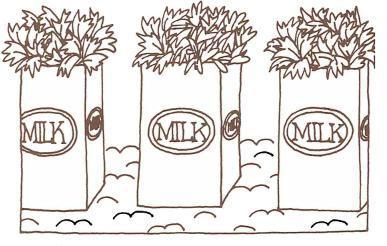Celery has a reputation fo r being a fussy, hard-to-grow vegetable. There's a lot of truth to that, but with the right climate and some care, you can grow large, tender plants. A dozen plants will take up five or six feet of row, and it's worth trying.
r being a fussy, hard-to-grow vegetable. There's a lot of truth to that, but with the right climate and some care, you can grow large, tender plants. A dozen plants will take up five or six feet of row, and it's worth trying.
Celery is challenging because it needs a long time to grow - up to 130 or 140 days of mostly cool weather - and it's quite demanding when it comes to water and fertilizer. 'Utah 52-70R Improved' is a good, well-adapted variety. If your soil stays moist and has plenty of organic matter in it, you're in good shape for growing celery. Shut off the water supply even for a short time, however, and you're in trouble.
The roots of celery plants are limited, usually stretching just six to eight inches away from the plant and only two to three inches deep, so the top part of the soil not only has to have enough moisture, it must also contain all the nutrients the plants need.
Keep Celery CoolCelery plants don't like hot weather at all. The crop will thrive only where the winters are mild, or where the summers are relatively cool, or where there's a long, cool growing period in the fall.
Getting StartedBecause celery takes such a long time to grow, in most parts of the country it's best to start the seeds in plant boxes or flats indoors to get a jump on the season. Celery seeds are slow to germinate, so soak them overnight to speed up the process. Plant them indoors 10 to 12 weeks before the last frost. When the plants are two inches tall, transplant them to individual peat pots or to another, deeper, flat with new potting soil. If you use flats, put the plants at least two inches apart.
TransplantingTransplant celery to the garden as early as a week or two before the last frost date. Plants should be four to six inches high when you set them out. Be sure to harden plants off first for a week to 10 days to get them used to spring weather. It the weather turns cold after you set your celery out (night temperatures consistently under 55° F for about two weeks), the plants may go to seed prematurely. But because of the need for a long growing season, it's often worth the gamble to set at least some plants out early.
To transplant celery, first work the soil, mixing in the fertilizer (about one pound of 5-10-10 per 30 square feet). Remove some of the outside leaves from each plant before setting them in. As with head lettuce, this trimming helps the roots recover from the transplant shock and resume normal growth more quickly.
Space the plants about eight inches apart, setting them a little deeper than they were growing in the flat. Mulch the plants after they're about six inches tall to help keep the soil moist and roots cool. It will also help to keep down weeds, which is important because celery grows slowly and doesn't appreciate any competition from weeds. If you don't mulch, be careful not to weed too deeply near plants. Celery has a shallow root system that can be harmed by deep cultivation.
Fertilizing and WateringSidedressings of 5-10-10 or a similar balanced fertilizer or manure tea in the second and third month of growth will help keep celery growing steadily. Use one tablespoon per plant and sprinkle it in a shallow furrow three to four inches from the plant and cover it with soil. Continue to apply manure tea weekly as you water the plants.
Give your plants plenty of water. If celery is short on moisture, or a hot spell hits, the stalks get tough and stringy. They can also develop hollow or pithy stalks in dry spells.
When celery gets big enough to eat, start harvesting the larger, outer stalks as you need them. The center will keep producing stalks. To harvest big plants at the end of the season, simply pull up the whole plant and trim off the roots.
BlanchingUnblanched celery has a deeper green color and a stronger flavor than blanched celery, and it's higher in nutrition. If you prefer the taste of blanched celery, try one of the self-blanching varieties, such as 'Golden Self-Blanching'. To blanch celery, open the tops and bottoms of half-gallon milk cartons and use them as "sleeves." Set the cartons over the plants a week, 10 days or even longer before you want to harvest. The color of the stalks will lighten, and their flavor will become milder.
Some people place boards close along each side of the row to blanch celery. Others simply bring soil or mulch up around the plant to block out the sun, although this method may let dirt fall into the interior of the stalks, making them hard to clean. Plants should be dry if blanched with soil or else they may rot.
There's no need to blanch the top leaves, of course, just the stalks.

Celery stores really well - you can keep it for many weeks with no trouble. Dig up the plants carefully, disturbing the roots as little as possible. Replant them in boxes of sand in your root cellar or set them close together in a trench in your cold frame where you can keep them from freezing. As long as the roots stay moist and the stalks dry, they'll really keep. Temperatures in the range of 35F to 40F are best for good storage.
 Victory Seed Company has all the seeds you want for your best garden in 2024.
Victory Seed Company has all the seeds you want for your best garden in 2024.
For 25 years, the family-owned Victory Seed Company has provided the highest quality vegetable, herb and flower seeds to families across the country. We are passionate about providing you the best seeds available that give excellent germination, robust plants, and the harvest you want. With a catalog of over a thousand varieties, we have everything, and our prices are the kinds that we'd want to pay. We have hundreds of yesterday's heirloom vegetables, as well as today's award winning hybrid selections. Get to know us by visiting our website and browsing through our online vegetable seed catalog.
| 1. Growing Watercress |
| 2. Plant Greens in Wide Rows |
| 3. Growing Wild Greens |
| 4. Growing Swiss Chard |
| 5. Growing Endive & Chicory |
| 6. Growing Celery ← you're on this article right now |
| 1. Growing Watercress |
| 2. Plant Greens in Wide Rows |
| 3. Growing Wild Greens |
| 4. Growing Swiss Chard |
| 5. Growing Endive & Chicory |
| 6. Growing Celery ← you're on this article right now |